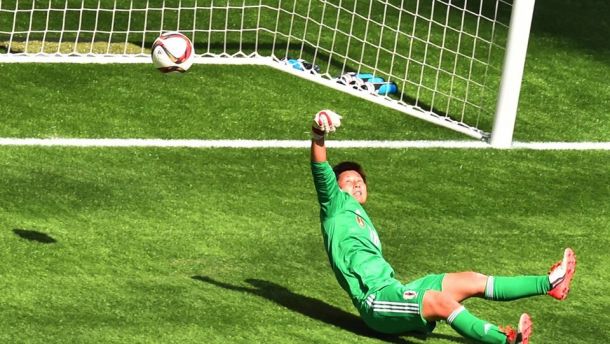The World Cup final was clearly an opportunity for the Lady Samurai Blues to assert their claim to what many saw as a rise to power. There was a perfect narrative, and one that interestingly involved the work of an enterprising American.
A commitment to grassroots over the last 20-25 years have turned the Land of the Rising Sun's soccer sides from afterthoughts to potential world powers. It was and still is a grassroots effort that combined Japan's unique popular culture with soccer fundamentals (especially regarding technical development and ball control for children as young as two).
It is a transformation and an ascendancy, in both Asian and world soccer that is rare in the world. Often times, competing in the same confederation as the world's best sides in games that matter to both sides (that aren't World Cup games) is a major advantage. Teams from only two confederations have ever won the men's World Cup--UEFA and CONMEBOL. Only two teams outside that confederation have ever placed fourth or higher at the (men's) event--the USA in 1930 and South Korea in 2002.
Why bring up the men's World Cup in an article about the women's tournament? It certainly seems like a fallacy because opportunities for women in other realms correlates well with performance at the Women's World Cup and the quality of women's player the country produces. It is a sad truth that has traditionally little to do with the actual soccer being played--even though some countries, like Brazil and Colombia, have produced skillful, technical players who can entertain. (Even in multi-ethnic Germany, France, etc., underprivileged and minority girls are often left out of women's sport, or not encouraged to pursue sport professionally.) As more nations start to professionalize women's soccer, especially those with top soccer pedigrees in the men's game and with strong soccer cultures to match, Japan (and perhaps China) will find itself on increasingly precocious soccer ground.
In the AFC Champions League, a tournament which relies heavily on native talent (as AFC clubs can have at most four or five non-Asian players on an entire professional roster, depending on the country), the Japanese teams noted for their technical ability at home are suddenly finding it difficult to not only get out of the group stage, but advance to the later knockout rounds of the competition. A Japanese side has not won the competition since 2008, and has only won the AFC Champions League once before 2008 in the Club World Cup era.
Tom Byer, the aforementioned American at the heart of Asia's soccer revolution, especially the one in Japan (where he is known as "Tom-San") and others (including Asian football journalist John Duerden) have noted how particular aspects of Japanese culture are holding back the club and (eventually) the national sides in comparison to other Asian sides, including South Korean, Australian, Chinese, Emirati, Qatari, and Saudi sides. As was once noted on Beyond the Pitch, the Japanese sides can play extremely technical, organized football and do so very well in J. League play, but there seems to be too much celebration and too much respect for the opposition on and off the pitch. Players who return to Japan from spells in Europe, the Middle East, or elsewhere in Asia note of the unconditional adoration from fans and opponents. In other words, despite promotion and relegation being a part of the Japanese pyramid, there really is little competitive pressure and little cultural incentive to adjust to beat their opponents (at this present time). (It is the adjustment to the fact wins, losses, and dropped points matter a lot more to the fans in Europe that is often the biggest difficulty in Japanese players being able to adapt to European soccer.)
In the match, the game as a celebration (and a party) mentality displayed itself in the lack of tactical adjustments by Norio Sasaki once they found the USA was blowing away their initial tactical plan. The team did create plenty of chances and scored two goals. But once the USA reacted, it reacted in a way that Italian fans would expect of their Azzurri or German sides of their Mannschaft. It played to put away the game by whatever means, even ugly ones, necessary to win the World Cup.
On the women's side, it meant almost no new faces on the side who were not on the side that won it all in 2011. It seemed like everyone was four years older, and had to rely on traits that often define players in more competition-oriented countries--impromptu vision, control the tempo (more), and tactical adjustments--in addition to the structure, fluidity, and organization the Lady Samurai have been known to play with. They were not going to be able to recover from injury, and had fewer younger players with the bravery to cause surprises for opponents in defense (or threaten them 1v1 or 1v2). In this match alone, the relentless, organized pressure put on by the United States women broke down the Japanese organization (in possession and defense) and put the final away by the thirtieth minute.
There are still concerns about the long-term soccer future of the USA women. For instance, the team featured only one non-white player (Sydney Leroux) in a country which is rapidly becoming less white and is not remotely close to fielding potentially one of the 51% of American school-age children in public school needing free or reduced lunch in a national team or professional squad in the next decade or two. But at least the USA women are still engrained with a competitive spirit, and there's a pressure to win and get better. And decisions leading to wins and losses at the national and club level (even though the clubs/franchises are relatively invisible) are scrutinized. There is still some pressure, maybe from the depths of "the soccer internet" and ones who are extremely critical of Sunil Gulati and the U.S. soccer establishment, to explore new ideas and to get past 'traditional bounds'.
There is no such pressure in Japan. According to Byer and others (including former manager Javier Aguirre), girls and women are sent home from practice when there is rain, and there isn't value on training in adverse or difficult conditions. And still, although there are some long-term effects of playing on artificial turf, most players from the best soccer nations adapt because they got used to playing on all sorts of surfaces, including dirt, sand, paved and unpaved streets, concrete, patched grass, wood, as well as turf. These are traits that are often picked up by all sorts of players around the world in the poorest of neighborhoods, from the least educated of backgrounds. Even the women, who often are marginalized away from professional sport, pick up some of those traits to not worry about protections or inhibitions. They have to be brave just to live, so they work that much harder. And they could not be picky with the turf they played on or the equipment they trained with. (The same is true with managers.)
These struggles rob Japan of critical depth in youth, which will become a liability if they do not adjust to an improving and expanding field. It will make their achievements in 2011-2013 and earlier, and even now, seem like better times. The last-minute England own-goal from this year's World Cup semifinal will become a divine miracle years down the road, if the struggles continue.
Sunday night was a showcase between a nation whose soccer culture could become its dominant culture and is along the innovation (even with destruction of the establishment) path to someday be the next dominant power in world soccer, if the innovation is allowed to proceed. The other is seeing their window close--even in women's soccer--unless it confronts problems it has across its soccer game, ones that are cultural.






































